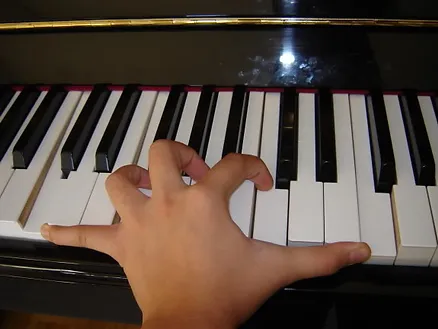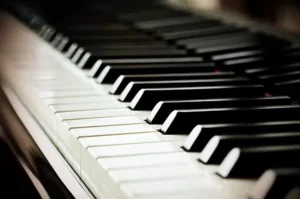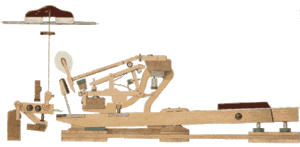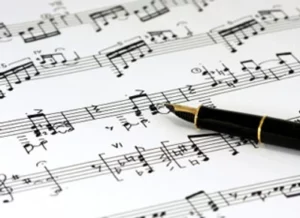Pain and the Piano: Why is it that, according to the research, 86% of all professional musicians complain of some playing related problems? Why do countless piano students and professionals suffer from pain, RSI, ganglia, carpal tunnel syndrome, technical and/or musical limitations.
There is help available, but first, why does this happen?

There are three main issues:
* The student is sitting at the wrong height (an easy fix)
* The student has too much tension (maybe from overcurling, twisting or from stretching too much)
* The fingers, hands and arms are not coordinated and there may be one or several breaks in the alignment.
Correct Seat Height
Of the many students that come for a first lesson, hardly any of them sit at the right height. The right height is the height where the finger, hand and arms are aligned in one piece and is parallel to the floor. The elbow will be roughly in line with the top of the white keys. For children who are growing, this will constantly change.
The correct seat height is not only dependent upon the height of the student. Rather, it is based on the ratio of the length of the arm to the length of the torso. So a student who has a long upper arm (coming right down to their pelvis) for instance, will sit relatively high. Shorter students who have short upper arms but a relatively longer torso will sit lower.
Sometimes a thousand words is more easily summarised with a short video. Here is a video of Edna Golandsky explaining how to find the correct seat height:
Tension
Anything that causes tension is going to slow down the playing. Try it out for yourself. Curl your fingers and see how fast your fingers move compared to allowing your fingers to have their natural shape (i.e., relaxed).
Now stretch your fingers out as far as they will go and try and move them quickly. Again, they won’t move as quickly as if they are not stretched.

We are told, often from the first lesson, that we need to curl our fingers and that we need to stretch our hands into a five finger position.
This student’s fingers are extremely overcurled – he’s probably doing this to keep his fingers out of the black key area

This person’s hand is in a natural position. The fingers are CURVED but not CURLED. The long fingers – even in young children – usually will be in the black key area.
This kind of hand position allows for the quickest movement of the fingers with the maximum amount of freedom.
There must be another way to get around the piano without being stretched out or without over curling the fingers. There is a way of playing the piano that eradicates this tension and it is called the Taubman Approach.

This person has a huge span – it would actually be bigger if the middle fingers weren’t retracted and pulled back as they are here. The pianist would be experiencing a lot of strain across their hand in this position. I wouldn’t want to have to try to and play this chord in a quick passage.
But Relaxation is not the Cure
You’re tense, so you need to relax then, right? Not exactly. Fully relaxed muscles are no good to you either. Fully relax yourself on to the floor and then try to walk. It takes an effort to get up and start walking. There is no momentum. There is no energy.
In fact, heavy relaxation on top of tension is worse than just being tense in the first place. Heavy relaxation is no good for speed.
There is an in between – a sweet spot – that allows us to move quickly without being tense. Just like walking. we are not completely relaxed but nor do we walk like robots.
In the meantime, if you suffer from tension, technical limitations, pain or injury related to the piano, there is help available!
Anthony van den Broek is a piano teacher, solo and chamber music performer and examiner with the Australian Music Examinations Board. He has over 25 years experience teaching piano to students of all ages and all levels: from beginner to the most advanced pianists. Anthony is the only teacher who teaches the Taubman Approach for piano technique in Sydney.






